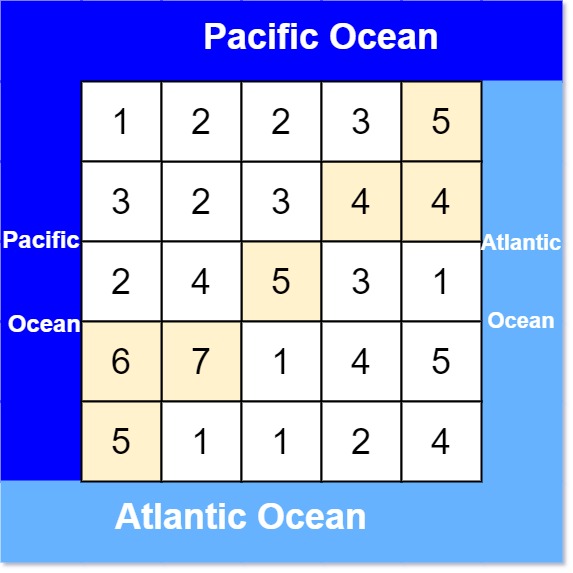There is an m x n rectangular island that borders both the Pacific Ocean and Atlantic Ocean. The Pacific Ocean touches the island's left and top edges, and the Atlantic Ocean touches the island's right and bottom edges.
The island is partitioned into a grid of square cells. You are given an m x n integer matrix heights where heights[r][c] represents the height above sea level of the cell at coordinate (r, c).
The island receives a lot of rain, and the rain water can flow to neighboring cells directly north, south, east, and west if the neighboring cell's height is less than or equal to the current cell's height. Water can flow from any cell adjacent to an ocean into the ocean.
Return a 2D list of grid coordinates result where result[i] = [r_i, c_i] denotes that rain water can flow from cell (r_i, c_i) to both the Pacific and Atlantic oceans.
Example 1:

Input: heights = [[1,2,2,3,5],[3,2,3,4,4],[2,4,5,3,1],[6,7,1,4,5],[5,1,1,2,4]]
Output: [[0,4],[1,3],[1,4],[2,2],[3,0],[3,1],[4,0]]
Example 2:
Input: heights = [[2,1],[1,2]]
Output: [[0,0],[0,1],[1,0],[1,1]]
Constraints:
m == heights.length
n == heights[r].length
1 <= m, n <= 200
0 <= heights[r][c] <= 10^5
題目 給定一個 m by n 矩陣 heights , 每個 cell height[r][c] 代表該位置的高度
每個 cell 的假設如果上面有水會從水平以及重直方向相鄰且高度較低的 cell 流去
假設 上方還有左方代表 pacific ocean, 下方還有右方代表 atlantic ocean
求寫出一個演算法找出可以同時流到 pacific ocean 以及 atlantic ocean 的所有 cell
直覺的作法是 從每個 cell 做 dfs 找出可以到 pacific ocean 以及 atlantic ocean 的檢查
如果只是這樣做因為每次都是從新尋找 所以複雜度會到 O((m*n)^2)
要優化檢查法 可以從一個觀察來看
首先最上方 還有 最左方的 cell 一定可以流到 pacific ocean
所以從海洋的觀點出法 只要找到 cell 值大於上一個 cell 的值就代表可以流到 pacific ocean
同樣地 最下方 還有 最右方的 cell 一定可以流到 atlantic ocean
而我們只要先對可以流到兩個 ocean 的 cell 做標記
然後 loop 矩陣每個值 , 只要檢查當下 的 cell 同時有可以流到兩個 ocean 標記 就是題目所求
而個別找尋標記可以從最邊緣做 dfs 搜尋下一個可以標記的
所以最多 O(m*n)

package sol
type Pair struct {
row, col int
}
func pacificAtlantic(heights [][]int) [][]int {
ROW := len(heights)
COL := len(heights[0])
pacific := make(map[Pair]struct{})
atlantic := make(map[Pair]struct{})
// find water enable cell
var dfs func(row int, col int, prevHight int, visit map[Pair]struct{})
dfs = func(row int, col int, prevHight int, visit map[Pair]struct{}) {
if row < 0 || row >= ROW || col < 0 || col >= COL || heights[row][col] < prevHight {
return
}
cell := Pair{row: row, col: col}
if _, visited := visit[cell]; visited {
return
}
visit[cell] = struct{}{}
dfs(row-1, col, heights[row][col], visit)
dfs(row+1, col, heights[row][col], visit)
dfs(row, col-1, heights[row][col], visit)
dfs(row, col+1, heights[row][col], visit)
}
for row := range heights {
dfs(row, 0, heights[row][0], pacific)
dfs(row, COL-1, heights[row][COL-1], atlantic)
}
for col := range heights[0] {
dfs(0, col, heights[0][col], pacific)
dfs(ROW-1, col, heights[ROW-1][col], atlantic)
}
result := [][]int{}
for row := 0; row < ROW; row++ {
for col := 0; col < COL; col++ {
cell := Pair{row: row, col: col}
_, inPacific := pacific[cell]
_, inAtlantic := atlantic[cell]
if inAtlantic && inPacific {
result = append(result, []int{row, col})
}
}
}
return result
}
